Norfolk Island pine trees have a strong association with the Christmas holiday season – but these conifers are houseplants that keep giving all year long!
And when you propagate your own, they give even more!
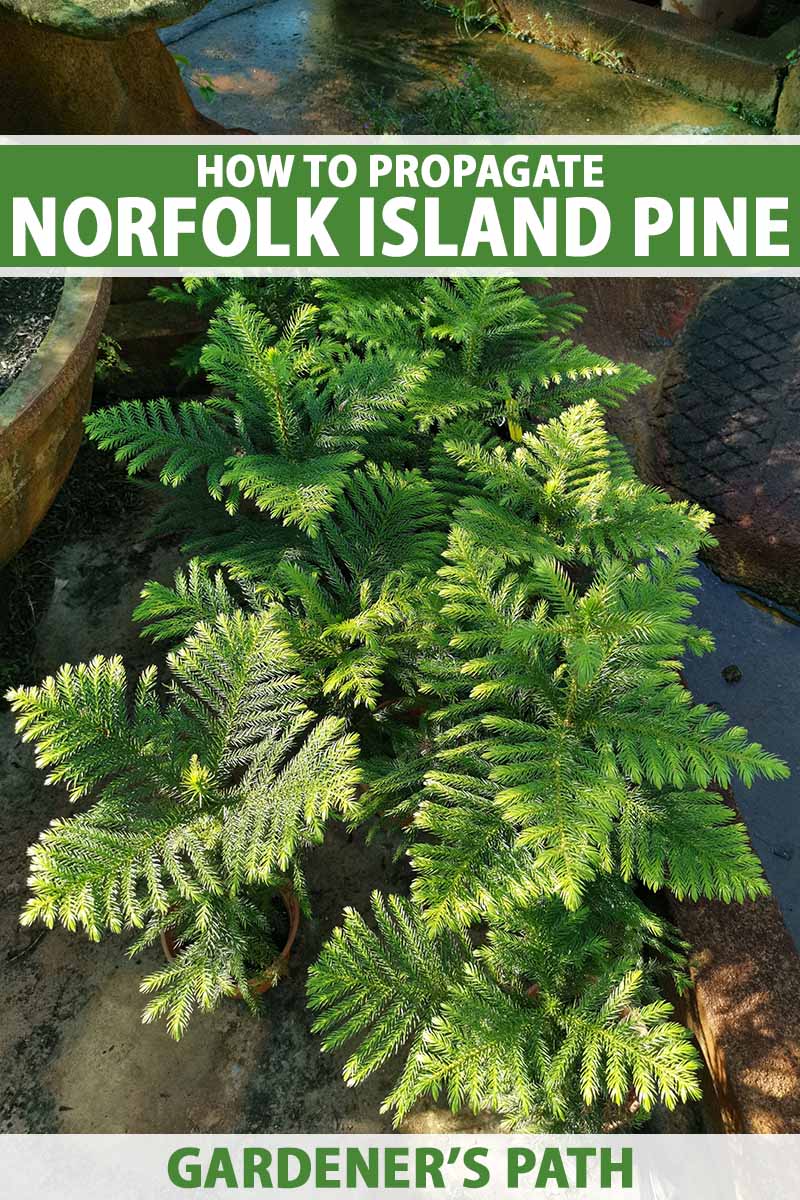
We link to vendors to help you find relevant products. If you buy from one of our links, we may earn a commission.
When it comes to propagating these living Christmas trees, you have a few options. I’m going to provide detailed instructions for three of these methods here.
Here’s a quick overview of everything I’m going to cover:
Propagating Norfolk Island Pines
If you’d like even more tips for growing these conifers, be sure to check out our complete guide to growing and caring for Norfolk Island pine trees.
From Seeds
While it can be tricky to source seeds for these tropical conifers, once you have them it’s not hard to succeed at this propagation project.
When you’re trying to find seeds, you might seek out an online seed exchange, or a small vendor who lives in a climate where these conifers can grow outdoors year-round.
Just make sure you obtain fresh seeds, since these don’t maintain their ability to sprout for very long. Within three months, about half of the seeds will lose their viability.
But before we get started with the how-to’s of this project, let’s get a better understanding of what we’re going to be working with.
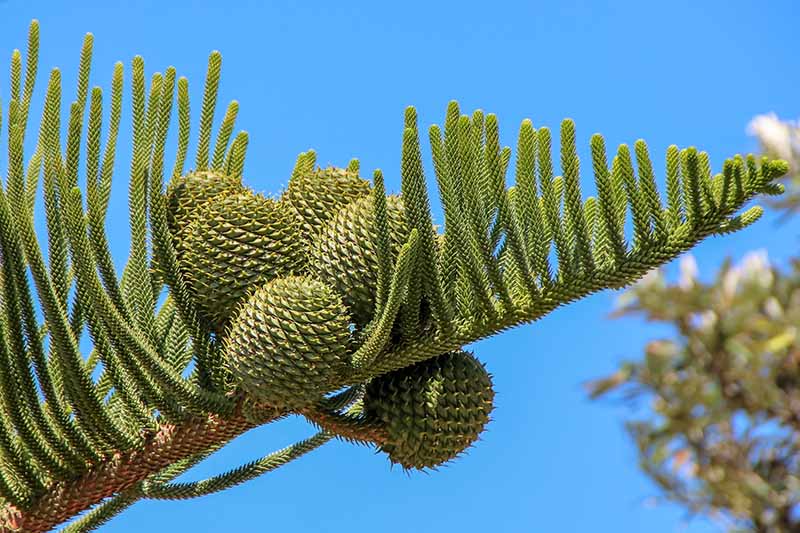
Norfolk Island pine seeds are produced within the plant’s cones. An entire cone is made up of dozens of seed capsules, each of which will contain a single seed if the plant is pollinated fully.
If you have an entire cone, you’ll want to remove the capsules from the cone first – but there’s no need to remove the seeds from the capsules.
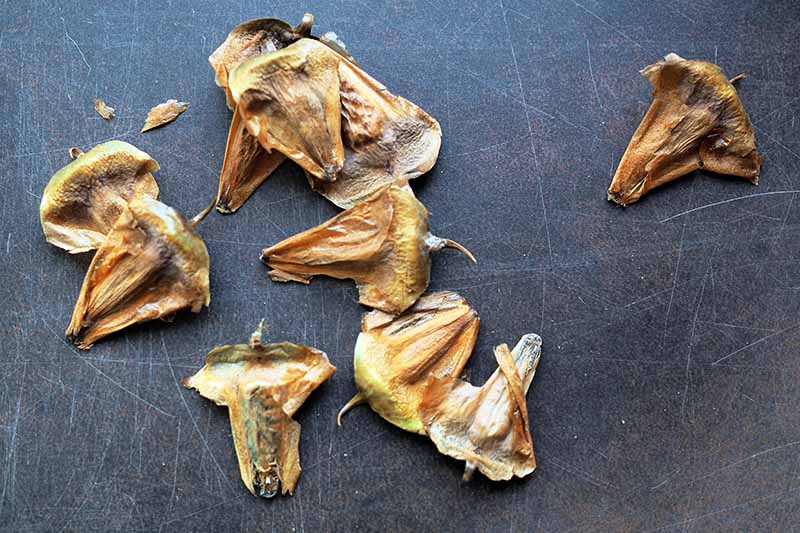
A Norfolk Island pine seed capsule is more or less wedge shaped, with a flattish end on top and a pointed end on the bottom – its shape reminds me very much of a shark’s tooth.
Knowing which end is the top and which is the bottom will come in handy when it’s time to plant these – but don’t worry, I’ll remind you.
In addition to the seeds, you’ll want to gather up your other supplies.
Here’s what you’ll need:
- small, clean nursery pots
- a spray bottle
- a humidity tent
- a sterile seed-starting medium
If you’d like a recommendation for the starting medium, I like Tank’s Pro-Lite Seeding and Potting Mix, a peat-free mix that contains organic coconut coir, perlite, and organic compost.
Tank’s Pro-Lite Seeding and Potting Mix
You can purchase it from Tank’s Green Stuff via Arbico Organics.
As for the nursery pots, decide whether you want a bushier looking houseplant with many individual trees growing in one pot, or a single tree per pot.
If you are going the single tree route, use two-inch pots. If you’re going for a bushier look, you can use four-inch pots.

Are you thinking of repurposing some old nursery pots? This is a laudable choice, just make sure to clean them first, and then sterilize them by wiping them down with hydrogen peroxide.
This will help to ensure that you don’t unknowingly transmit any plant pathogens to your seedlings.
Next, fill your pots with starter mix, leaving a half an inch to an inch of rim between the top of the surface of the soil and the top of the pot. This will help ensure that watering is mess-free.
Now insert the seed capsules into the soil, pointy part down. If they were shark’s teeth, the shark would be biting into the soil.
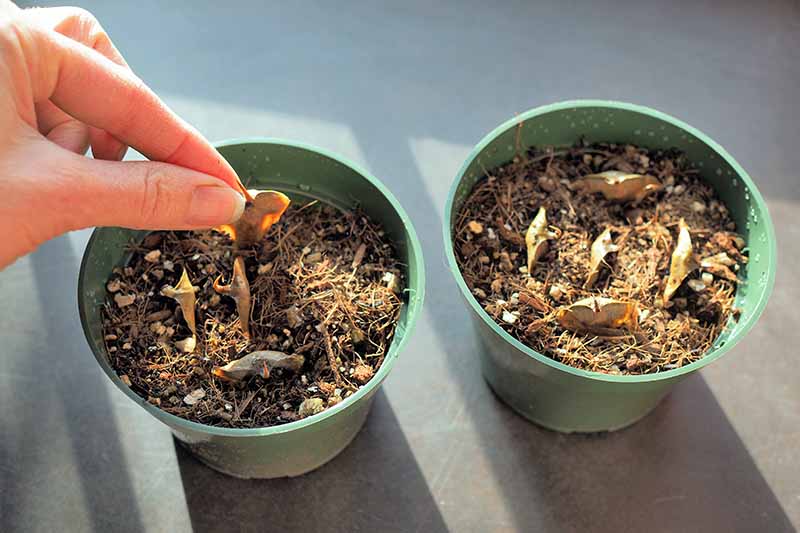
If you are sowing multiple seeds into the same pot for a bushier look as we discussed above, space them out evenly, with the seeds about a half an inch apart.
On the other hand, if you’re sowing only one seed per pot, center it in the middle of your container.
Once your seeds are sown, you’ll want to water them in by spraying them with your mister. This will make the top layer of the soil and the seeds moist without creating overly soggy soil.
To keep humidity levels up during germination, cover the pot with a plastic baggy secured with a rubber band.
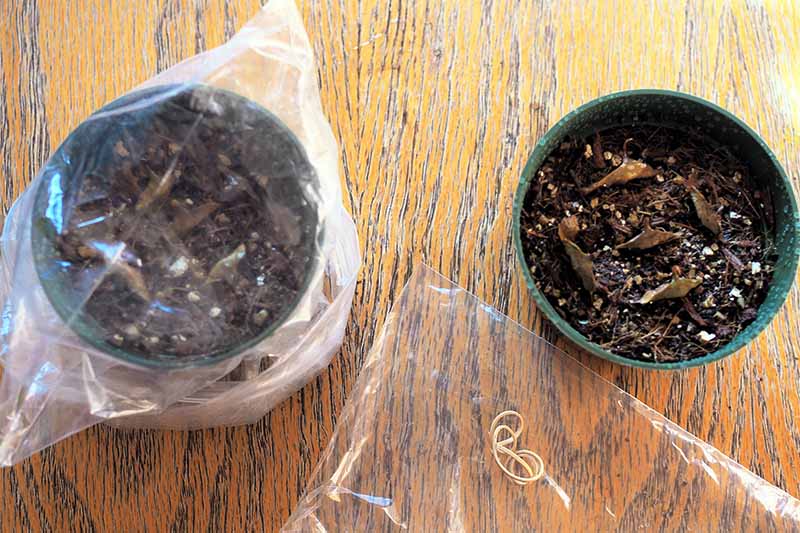
If you aren’t a fan of the DIY look of a plastic baggy placed over the pot, you could use a grow tray with a humidity dome.
Place your pots inside the tray, then cover with the transparent plastic dome. You can find a set of plant trays and humidity domes available for purchase via Amazon.

Three Pack Set of Starter Trays and Humidity Domes
Once your soon-to-be-trees are watered in and enclosed to ensure high humidity, place them in a location with plenty of bright light and a temperature of around 70 to 80°F.
If you don’t have a bright, warm window to use, you may want to use a grow light and a heat mat to help maintain these conditions.
If you’re in need of a heat mat, the Jump Start heat mat will fit on a windowsill, and it is available from the Hydrofarm Store via Amazon.

Continue spraying your seeds and the top of their growing medium daily until they germinate. Keep the top inch of the soil moist but not soggy. Within 10 to 21 days, your seeds should sprout.
At this point, you can start to remove their humidity tents, though it’s preferable to go about this process gradually, exposing your young saplings to “normal” living conditions little by little instead of all at once.
As your young saplings get established, keep them at a temperature between 60 and 90°F.
At this point, your saplings should be watered instead of just being misted. Water them when the top of their soil dries, being sure to water at the soil level without sprinkling the plants.
As they grow, repot your living Christmas trees as needed.
From Cuttings
When you grow a new plant from a cutting, you’re acting as a bit of a mad scientist, creating a clone of the parent plant. But no fancy equipment needed for this cloning experiment! Bet you didn’t know you had it in you, did you?
Although growing cuttings of Norfolk pines is certainly possible, it’s not as easy as, say, growing hoya or spiderwort from cuttings – a couple of other home experiments in cloning.
One of the caveats with propagating cuttings from this conifer is that taking a cutting from a branch will result in a cutting that continues to grow like a branch.
If you don’t want a new plant that grows like a branch, you can take a cutting from the central growing tip, but this may mean sacrificing the parent plant since there is only one growing tip on Norfolk Island pines.
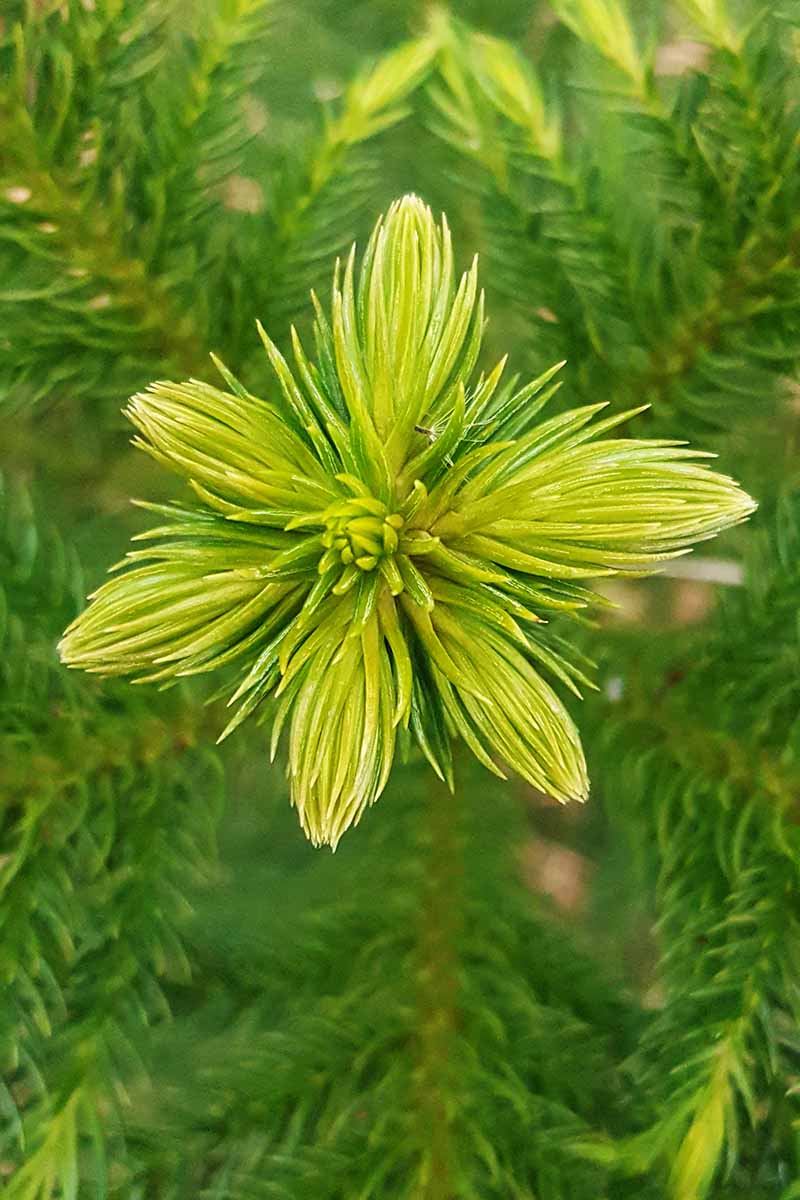
Performing such an operation will at best cause your plant to lose its symmetrical shape, and at worst, could kill it.
There is, however, a reason you may want to risk such an operation – if your conifer has outgrown your home and you’d like to keep part of it alive rather than rehoming it.
If you’re ready to give this project a try, you’ll need these supplies:
- a mature Norfolk Island pine tree to take cuttings from
- a sterile growing medium
- one four-inch nursery pot per cutting
- a pair of pruners
- scissors
- a spray bottle
You might also want to use rooting hormone powder or gel, a plastic bag and a rubber band or a terrarium, and a pencil or chopstick.
Fill your nursery pot with soil, leaving a half an inch of space or so between the surface of the soil and the rim of the pot.
With clean, sterilized pruners, take a cutting from your houseplant – it should be four or five inches long.

Next, use a pair of clean, sterilized scissors to trim the needles from the bottom two inches of the cutting.
If you are using a rooting hormone product,this is the time to apply it to the cut end of the cutting. I like Olivia’s Cloning Gel, which is available at Arbico Organics.
Next, poke a hole in the center of the growing medium with a pencil, a chopstick, or your finger.
Insert your cutting into this hole. If the cutting seems a little too tall in its pot and wants to tip over, use your snips to trim a bit more from the cut end until it seems stable in its container.
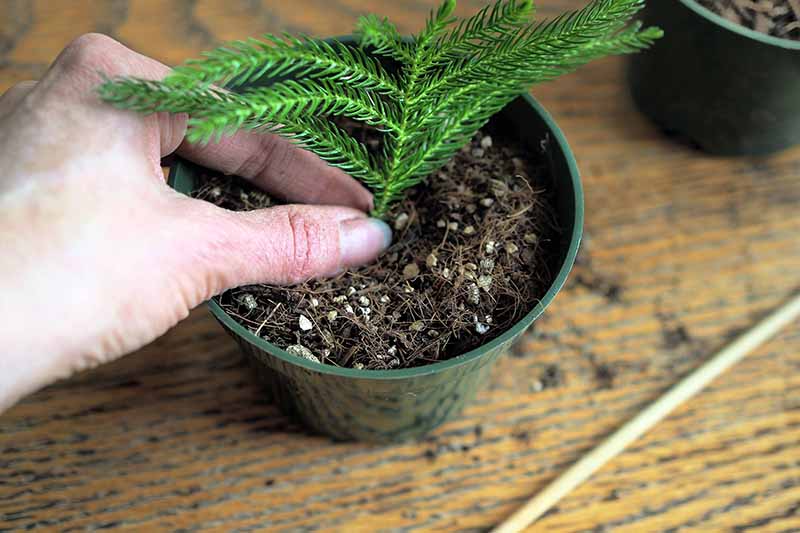
Finally, moisten the growing medium with your spray bottle so it is moist but not soggy. This will be your watering routine while the cutting roots itself. Watering in this manner will prevent waterlogging.
Keep the cutting in warm soil. A heat mat, as mentioned above, can help keep your cutting warm.
I also recommend using a humidity tent to keep humidity levels up. You can create a makeshift humidity tent with a transparent plastic baggy secured with a rubber band, or you could place your cutting in a terrarium or greenhouse.
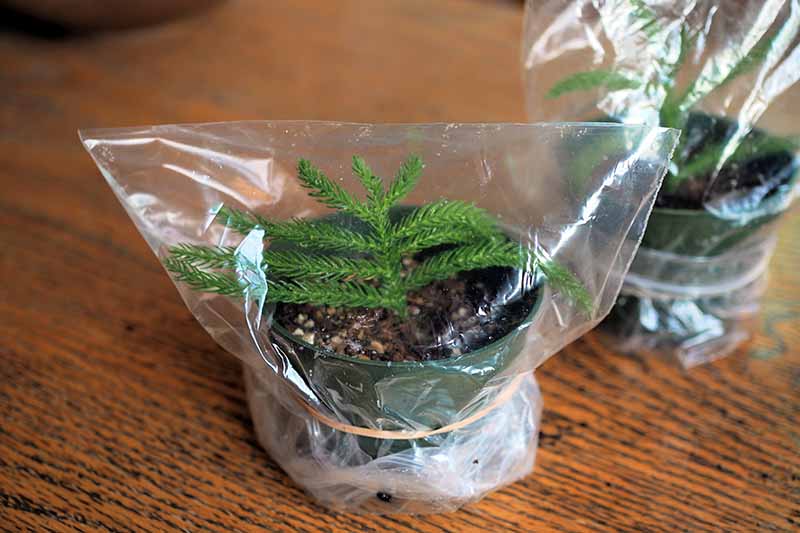
Water with your mister whenever the surface of the soil is dry – this may be every day or more often, depending on the conditions in your home.
You’ll know your cutting is rooted when a gentle tug is met with resistance. At this point, start watering your little clone by pouring water over the soil surface, letting the top inch dry between waterings.
You can learn more about watering Norfolk Island pines here.
Via Division
If you’re interested in propagating Norfolk Island pines to generate more plants for your home, one of the easiest ways is to divide existing plants.
This isn’t a true form of division, but it is an easy way to get more specimens.
Let me explain.
True plant division is carried out at the root of plants, often via their rhizomes, corms, or tubers.
Let’s take potatoes, for instance. You plant one potato spud in your spring garden, come back a few months later, and now you have several spuds. Each spud, if planted separately in the soil, can grow into a new plant.
When we “divide” Norfolk Island pines purchased originally from a nursery, that’s not at all what we’re doing. We’re simply separating individual plants that have been grown together in one pot.
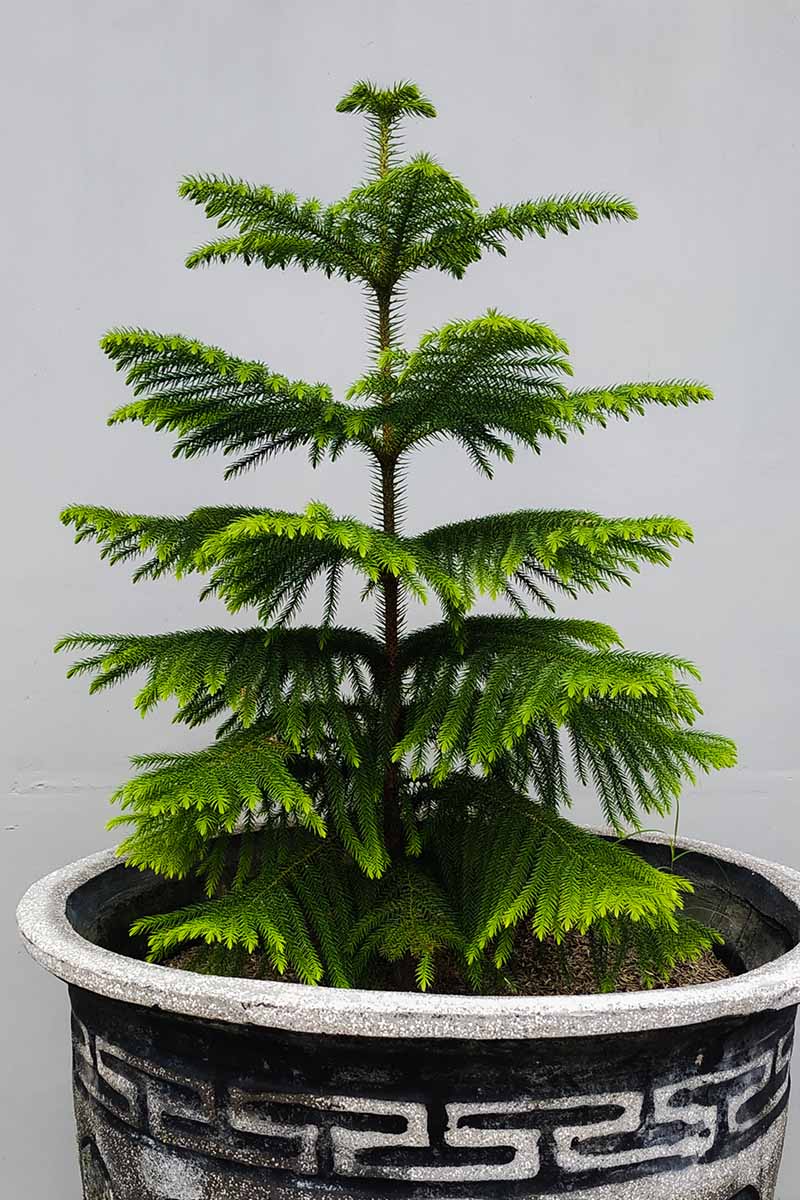
Commercial growers of these conifers often grow more than one tree per pot. This technique results in a bushier, fuller houseplant – which is not actually a single houseplant at all, but rather, a clump of densely planted trees.
If you don’t need or want such a bushy houseplant, you can turn your clump of Norfolk pine trees into two – or even more, depending on how many individual trees are growing in your pot.
There is one caveat to this propagation project – some of the individual trees may not survive the operation, so if you proceed, handle your houseplant very gently and be prepared for some potential loss.
Before you get started, examine how many stems are in your pot – that’s how many trees you have. Now decide how many specimens you want to divide your houseplant into, and have pots of soil at the ready.
In many cases, this operation will be easier to perform on smaller specimens with less developed root systems than on larger ones.
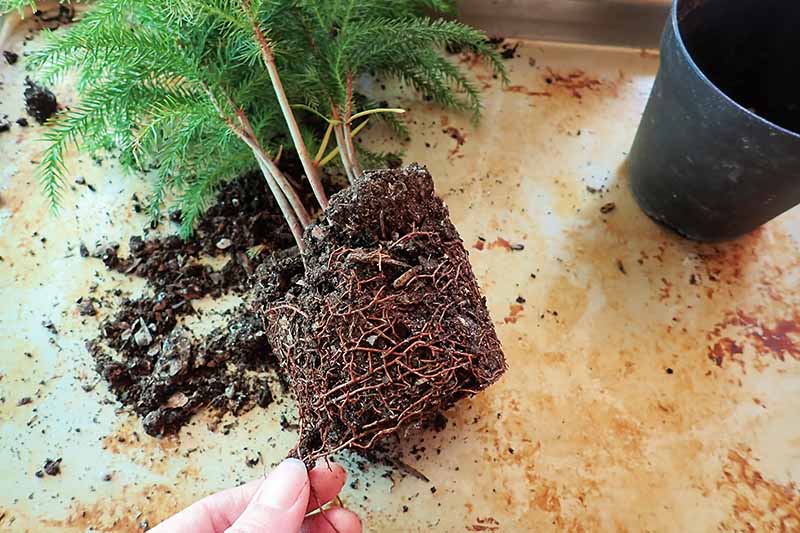
First, remove the plants from their pot and examine the roots.
If they are so tightly bound that you can’t separate them without cutting them, you may want to explore other options for propagating this conifer so you don’t risk damaging your plant.
On the other hand, if the roots are easy to work apart, then you can proceed without fear – but do so gently and be aware that each tree may not survive.
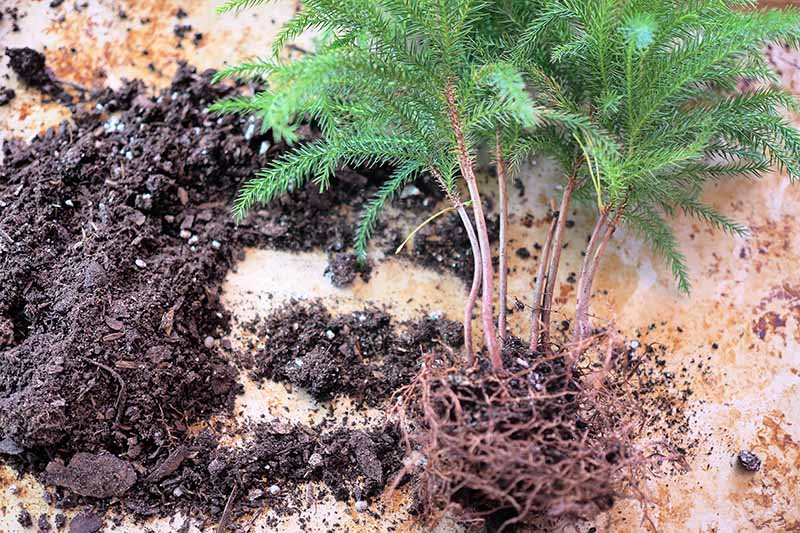
If you’re going to pot up each tree individually, follow each stem down to the crown and gently untangle its roots from the roots of the other trees.
On the other hand, if you want to maintain some fullness, consider dividing your clump of trees into just two or three sections.
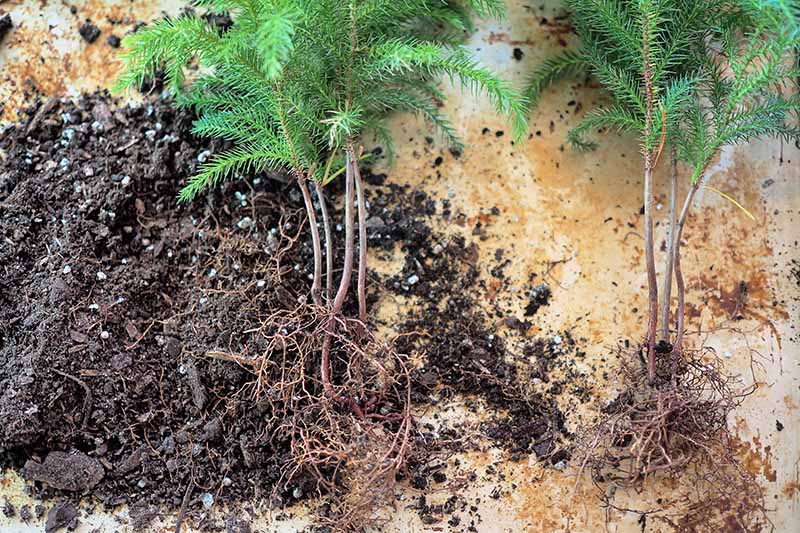
In this case, you don’t need to separate out each individual tree, just work two or three clumps apart from each other, depending on your goal.
Once you have the roots divided, pot up your plants.
You can find detailed instructions for potting these conifers in our guide.
Start Your Own Living Christmas Trees
Now that you know how to start your own living Christmas trees, you may even want to forego the traditional cut version.
Who needs a dying tree in the living room for the holidays when you can have a collection of beautiful, living, Norfolk Island pines?
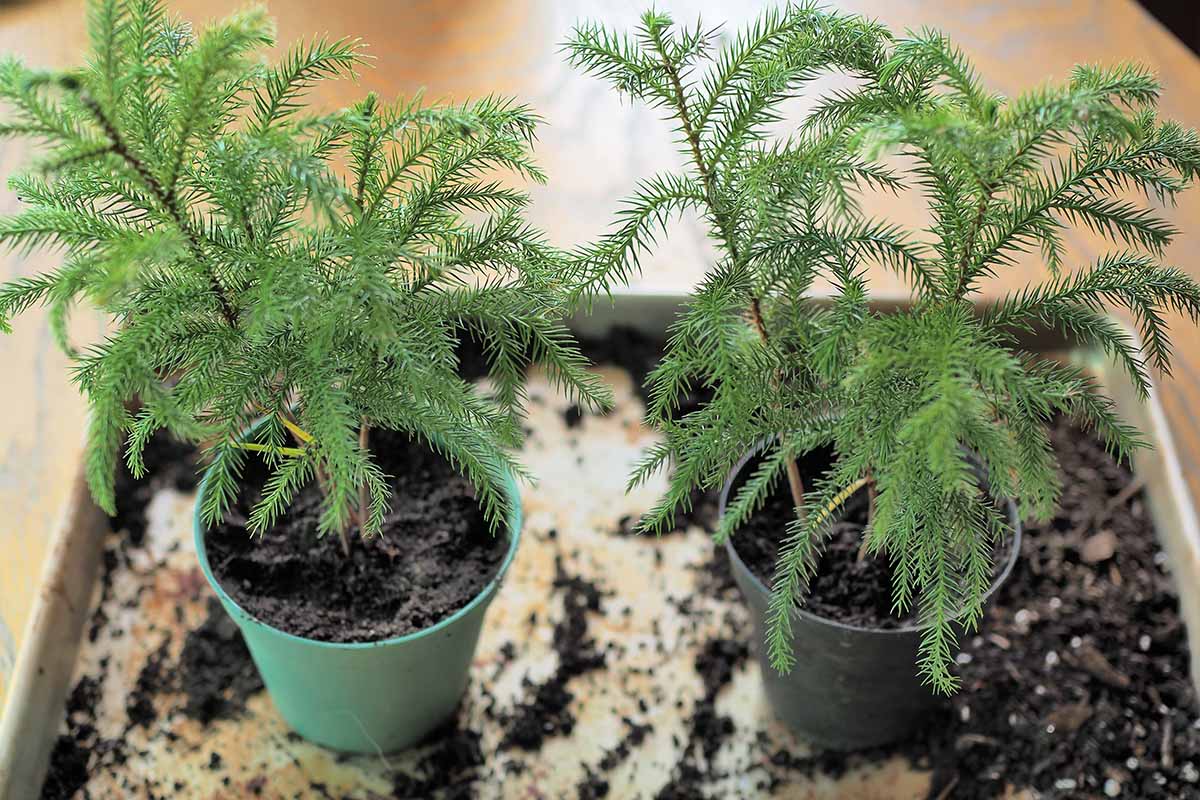
With three propagation methods to choose from, which are you going to try? Have you experimented with any of these methods on your own yet? If so, how did it go? Let us know in the comments section below!
And if you’re looking for more houseplant propagation ideas, be sure to check out these articles next:
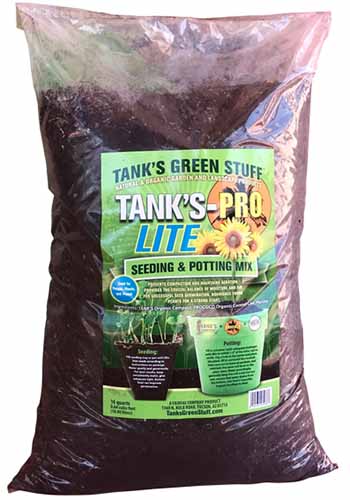
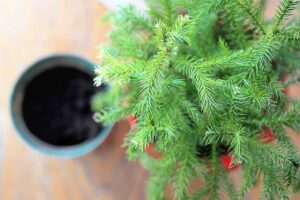
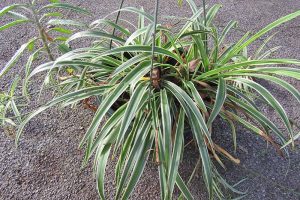

Very helpful article. One of the most inclusive I have read.
I have 2 separate Pines (given as gift) 3 yrs ago and even though they are doing well…this article has given many good pointers to keep them healthy.
Hi there,
Thanks for your kind comment! If you need any other tips, you may want to check out our complete guide to growing Norfolk Island pines, right here.
Best of luck for the continued good health of your trees!
I would like to propagate mine, but am not ready to sacrifice the very top. How does a branch propagation grow? Sideways? Will it eventually develop a top?
Hi Martha,
Yes, a cutting taking from a branch will grow more like a branch, and never like the top of the tree. I have propagated cuttings in this way but they are still too small to know what they will look like once they size up. If you look at the photos above under the “From Cuttings” section, you’ll see what they look like.
Hope this helps inform your decision!
Hi! Thank you, it was a very good article. I want to propagate my two Pines. I have had them for 10 years and they have grown huge, but last summer they got sunburnt and only tips of the plant remained healthy. I decided to propagate them from top. Is it important to wait until spring as they are in the rest mode in winter? And the other question: as I understand, pines need lower room temperature. But you wrote about warming mat to warm up the topsoil. Do the trees survive in the warmer temperatures? Thank you!
Hi Kerttu, Thanks for your kind words about this article, I’m glad it was helpful. it really depends on your plant and your conditions as to whether you can propagate now or should wait until spring – if you are seeing any growth on your plant currently, now might be just a good time as in the spring. The heat mat is more important when propagating from seeds. Since you are taking cuttings try to keep them between 60-72 degrees Fahrenheit while they are rooting. It will depend on your conditions on whether you need a heat mat to attain… Read more »
Hi,
My Norfolk Island Pine has sprouted a baby on one of the branches!!! What do I do with it? I’m trying to attach some pictures but I don’t think they’re attaching, so I emailed the pics too:)
Hi Liz, apologies, we’ve been having some issues with photos uploading, so I’ve attached them here.
Hi Liz,
Before I answer your question, I’d like to clarify what I’m seeing in your photos. The branch that is producing this new shoot, or baby as you called it, does it go all the way to the soil or is it a branch of the main trunk? And is there just one plant in the pot (one stem coming out of the soil) or are there several?
The branch that it’s on is off the main stem, at about 4’ up. There’s 3 stems all together, tightly growing together.
Hi Liz, Thanks for clarifying. The reason I asked for clarification is that if you have three trees (and so, three different trunks) growing in your pot, I thought that perhaps the growing tip of one of them had been damaged and was growing a new tip. That certainly can happen! However, based on your description, it sounds like the shoot is coming from a branch, not a trunk. Normally, Norfolk Island pines don’t produce new growing tips (upward growth) from branches, though they can easily produce new branch growth (sideways growth) if the branch is injured. At first, that… Read more »
Great article! What do you mean by a “sterile” growing medium. My tree has grown too large to bring in for winter. It has 4 “parent” trees in the pot. I want to follow your advice for cutting the central tops to re-root 4 new trees. I did by bags of both Organic Seed Start Mix and also Organic Container Soil Mix. Will either of these work?
Hi Diane,
The recommendation to choose a “sterile” growing medium is to reduce the chance of infection. Seed starting mix would be the better choice here to start with. I also highly recommend that you use rooting hormone for better chances of survival.
Another question – If I clip the center parent tree at the top and replant it, can I also plant a couple of the “branch” clippings (clipped from the bottom of that parent branch, as per the article’s instructions), to plant in the same pot around the parent branch to make a fuller looking houseplant? I am attaching photos of my 4 parent tree cuttings as well as of the clipped bottom branch cuttings. As you can see my parent tree is quite large, not sure if I can root these into 4″ pots as the article suggests.. I may… Read more »
Hi again, Diane, So it looks like you’ve already gotten started cutting your tree. If you insert a top cutting as well as side cuttings into the same pot, no, it’s not really going to look like a new, full tree. You can certainly try it to save space, but keep your expectations low. In my experience rooted side branches don’t grow much. Please keep in mind that, as I said in the article, rooting these trees from cuttings is not always successful. But my fingers are crossed for you and I wish you the best of luck! Let us… Read more »
Two more questions (I promise!). Can you root the cuttings in water as you can with so many other houseplants? If not …. can I add perlite and sand to my organic potting soil (already have bags of), will that work too?
Hi there,
No, these don’t root well in water, unfortunately. As for your organic potting soil, if it’s designed for outdoor plants it might not be sterile enough, and adding perlite and sand won’t change that. A growing medium for houseplants would be better, such as this mix of coconut coir and perlite, available at Amazon. Hope this helps!